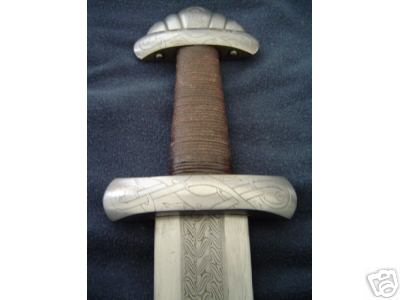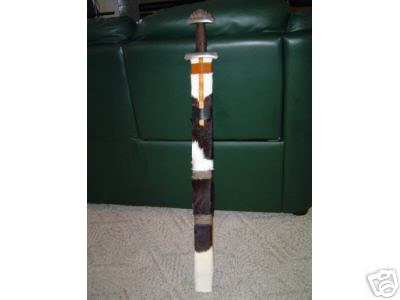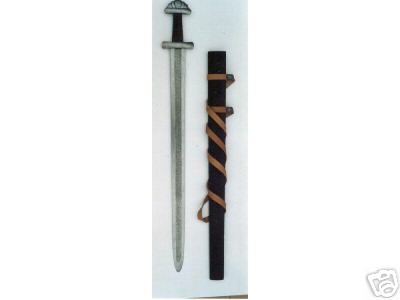We travel now a millenia from the Viking age to the fall of the "Iron Curtain" and the opening of economic and political relationships betwee the west and the countries of East Europe -- to be specific, the Czech Republic. For some reason or another, the Czech Republic has become a hotbed of reproduction ancient arms manufacture. There are several individuals and companies there which turn out all sorts of swords, many of them made "the old way" ie, forged over hot coals, one at a time, by hand.
One of the names which comes up often in a discussion of Czech sword making is that of Patrick Barta. He has established a bit of a reputation in the west as a swordmaker of great skill, who pays close attention to details. And his work is very affordable to western collectors. As well, he has made several swords for dispay in museums across Europe. Among his specialties are pattern-welded swords of the Viking era. So when the opportunity came for me to examine one of his swords first hand, knowing Mr. Barta's reputation (and not wanting to go through the 2 years wait), I jumped on it. Although his swords are affordable, they still aren't very common over here in the States.
This particular sword is #A05 on Patrick's website: http://www.templ.net/weapons/antiquity_and_ea...ge.php#A05 . It is based on a sword found in Oppland, Norway. This sword is described (and illustrated) in Ian Pierce's Swords of the Viking Age on pages 102-103. It has a hilt of Petersen type S/Wheeler type III. The blade is broken and may have been the victim of a ritual sacrifice. According to Ian Pierce, due to the size of the hilt, the blade "may have been massively long".
And speaking of massive -- that's a good way to describe this sword! It is large, perhaps one of the largest Viking-style swords I have ever handled.
Here are some numbers:
Weight: 4 lbs
Overall length: 39 inches
Blade length: 31.75 inches
Blade width: 2.25 inches
Hilt length: 7 inches
Grip length: 4.1 inches
PoB/CoG: 5 inches
CoP: 24 inches
Yes, it is massive, and quite heavy in the hand. The balance is decent, but much swinging of this sword would be quite a work-out in any case.
It is beautifully made. The pattern-welded blade (of a blodida pattern, I believe) is historically accurate and very attractive, and has a decent distal taper. The pommel is also historically accurate, being made of two parts, the top piece riveted to the bottom piece, covering the peened tang. The engraving is beautifully done (the original's hilt was silver plated; alas, this one is plain steel. Though I am certain Patrick could plate it on special order).
The sword comes with a scabbard. It's a wood core scabbard, with cowskin covering -- real cow skin. It's a furry scabbard!
This is a beautiful sword, and Patrick Barta's craftsmanship is amply demonstrated here. My main criticism is of it's weight -- it could stand to lose a pound or so. Doing that would improve handling dramatically.
But overall, what a deal this sword is! An authentic pattern-welded sword of high quality for an insanely low price, you just can't beat that. No, it's not Kevin Cashen or Vince Evans level work, but it's a darn good deal for the price. If Patrick works on improving handling characteristics (especially weight), he will be even tougher to beat.




